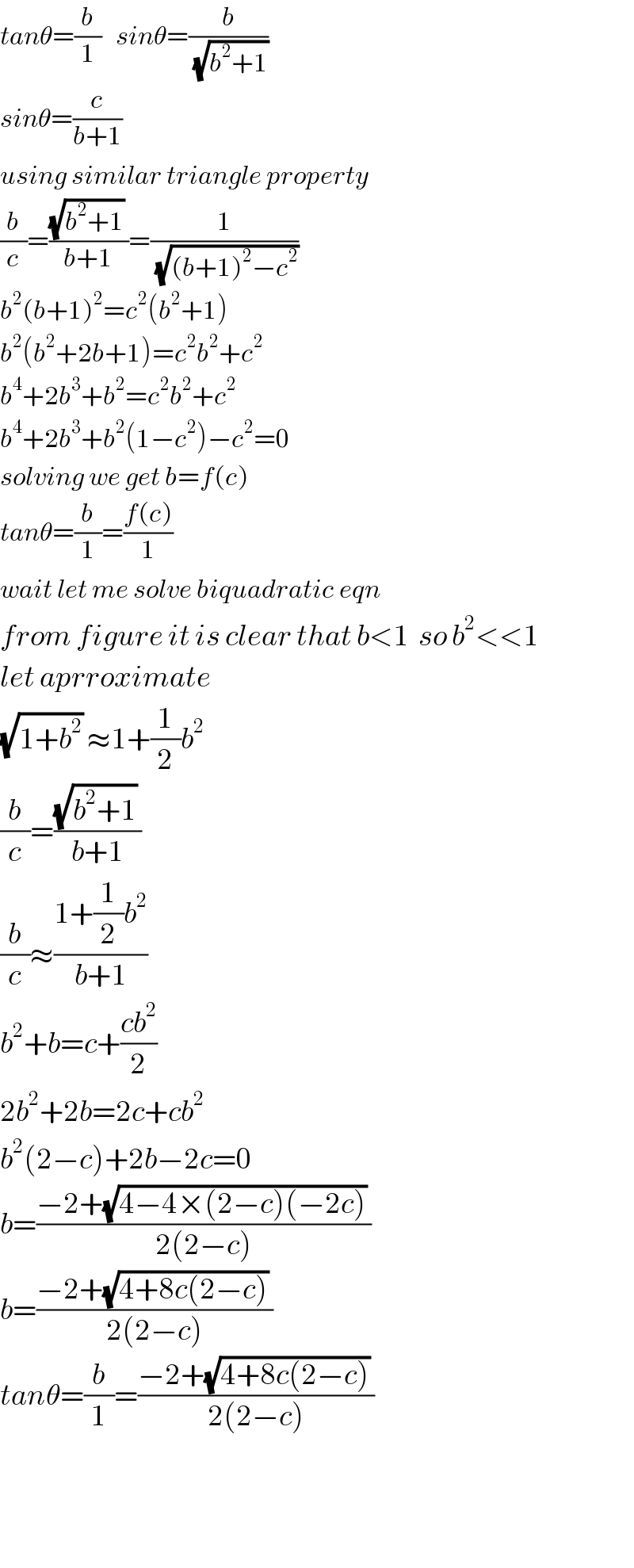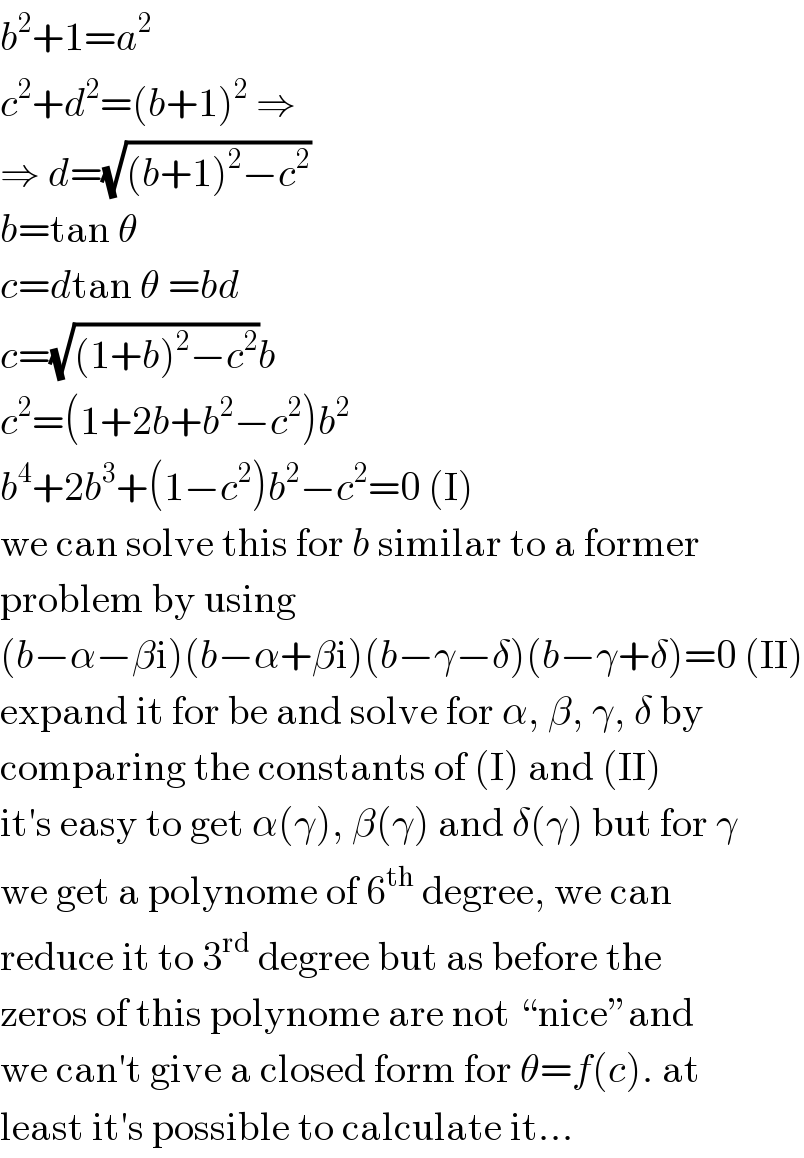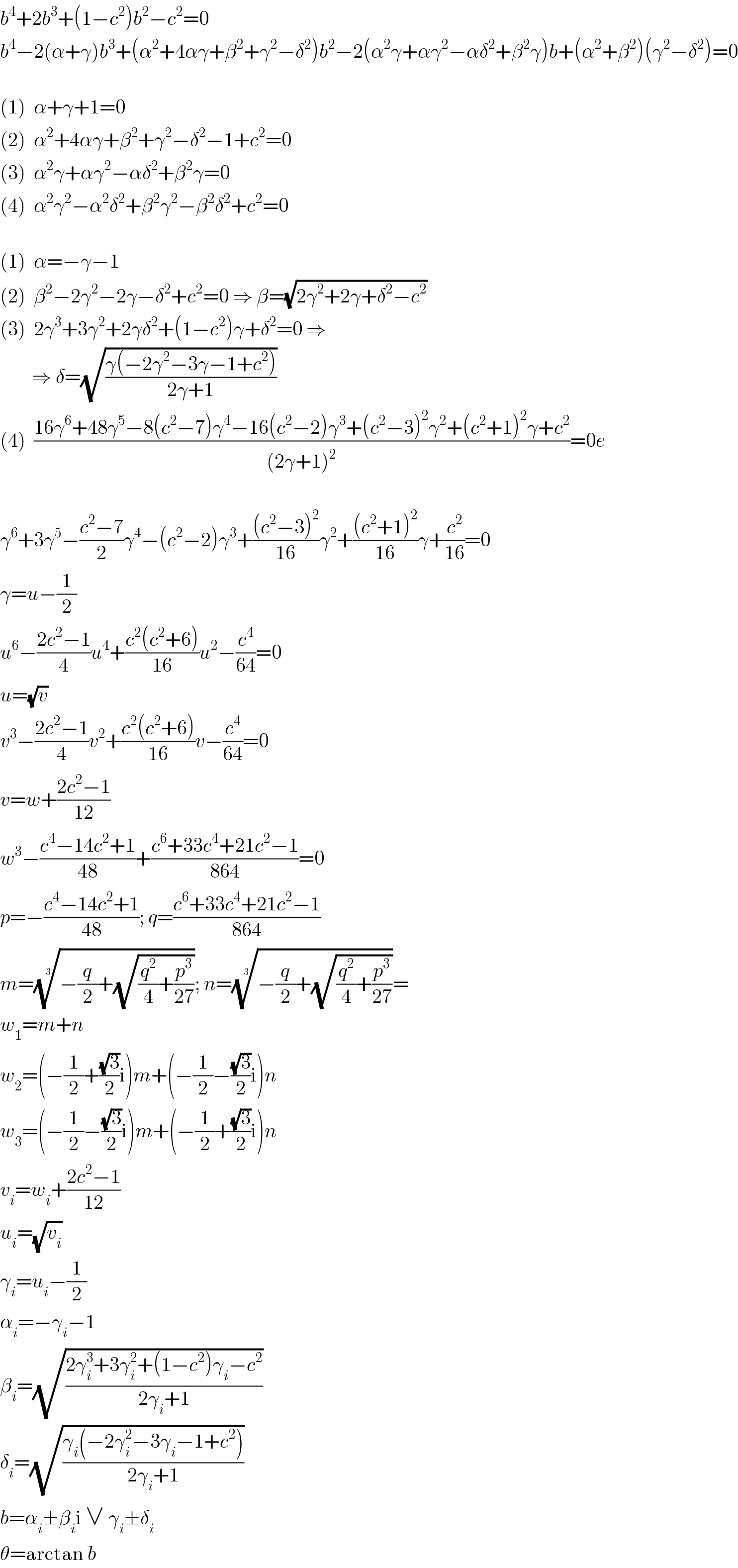Question Number 38600 by ajfour last updated on 27/Jun/18

Commented by ajfour last updated on 27/Jun/18

$${Find}\:\theta\:{in}\:{terms}\:{of}\:\boldsymbol{{c}}\:. \\ $$
Answered by tanmay.chaudhury50@gmail.com last updated on 27/Jun/18

$${tan}\theta=\frac{{b}}{\mathrm{1}}\:\:\:{sin}\theta=\frac{{b}}{\:\sqrt{{b}^{\mathrm{2}} +\mathrm{1}}} \\ $$$${sin}\theta=\frac{{c}}{{b}+\mathrm{1}} \\ $$$${using}\:{similar}\:{triangle}\:{property} \\ $$$$\frac{{b}}{{c}}=\frac{\sqrt{{b}^{\mathrm{2}} +\mathrm{1}}\:}{{b}+\mathrm{1}}=\frac{\mathrm{1}}{\:\sqrt{\left({b}+\mathrm{1}\right)^{\mathrm{2}} −{c}^{\mathrm{2}} }} \\ $$$${b}^{\mathrm{2}} \left({b}+\mathrm{1}\right)^{\mathrm{2}} ={c}^{\mathrm{2}} \left({b}^{\mathrm{2}} +\mathrm{1}\right) \\ $$$${b}^{\mathrm{2}} \left({b}^{\mathrm{2}} +\mathrm{2}{b}+\mathrm{1}\right)={c}^{\mathrm{2}} {b}^{\mathrm{2}} +{c}^{\mathrm{2}} \\ $$$${b}^{\mathrm{4}} +\mathrm{2}{b}^{\mathrm{3}} +{b}^{\mathrm{2}} ={c}^{\mathrm{2}} {b}^{\mathrm{2}} +{c}^{\mathrm{2}} \\ $$$${b}^{\mathrm{4}} +\mathrm{2}{b}^{\mathrm{3}} +{b}^{\mathrm{2}} \left(\mathrm{1}−{c}^{\mathrm{2}} \right)−{c}^{\mathrm{2}} =\mathrm{0} \\ $$$${solving}\:{we}\:{get}\:{b}={f}\left({c}\right) \\ $$$${tan}\theta=\frac{{b}}{\mathrm{1}}=\frac{{f}\left({c}\right)}{\mathrm{1}} \\ $$$${wait}\:{let}\:{me}\:{solve}\:{biquadratic}\:{eqn} \\ $$$${from}\:{figure}\:{it}\:{is}\:{clear}\:{that}\:{b}<\mathrm{1}\:\:{so}\:{b}^{\mathrm{2}} <<\mathrm{1} \\ $$$${let}\:{aprroximate} \\ $$$$\sqrt{\mathrm{1}+{b}^{\mathrm{2}} }\:\approx\mathrm{1}+\frac{\mathrm{1}}{\mathrm{2}}{b}^{\mathrm{2}} \\ $$$$\frac{{b}}{{c}}=\frac{\sqrt{{b}^{\mathrm{2}} +\mathrm{1}}\:}{{b}+\mathrm{1}} \\ $$$$\frac{{b}}{{c}}\approx\frac{\mathrm{1}+\frac{\mathrm{1}}{\mathrm{2}}{b}^{\mathrm{2}} }{{b}+\mathrm{1}} \\ $$$${b}^{\mathrm{2}} +{b}={c}+\frac{{cb}^{\mathrm{2}} }{\mathrm{2}} \\ $$$$\mathrm{2}{b}^{\mathrm{2}} +\mathrm{2}{b}=\mathrm{2}{c}+{cb}^{\mathrm{2}} \\ $$$${b}^{\mathrm{2}} \left(\mathrm{2}−{c}\right)+\mathrm{2}{b}−\mathrm{2}{c}=\mathrm{0} \\ $$$${b}=\frac{−\mathrm{2}+\sqrt{\mathrm{4}−\mathrm{4}×\left(\mathrm{2}−{c}\right)\left(−\mathrm{2}{c}\right)}\:}{\mathrm{2}\left(\mathrm{2}−{c}\right)} \\ $$$${b}=\frac{−\mathrm{2}+\sqrt{\mathrm{4}+\mathrm{8}{c}\left(\mathrm{2}−{c}\right)}\:}{\mathrm{2}\left(\mathrm{2}−{c}\right)} \\ $$$${tan}\theta=\frac{{b}}{\mathrm{1}}=\frac{−\mathrm{2}+\sqrt{\mathrm{4}+\mathrm{8}{c}\left(\mathrm{2}−{c}\right)}\:}{\mathrm{2}\left(\mathrm{2}−{c}\right)} \\ $$$$ \\ $$$$ \\ $$$$ \\ $$
Answered by behi83417@gmail.com last updated on 27/Jun/18

$$\boldsymbol{{c}}^{\mathrm{2}} +\left(\frac{\boldsymbol{{c}}}{\boldsymbol{{tg}\theta}}\right)^{\mathrm{2}} =\left(\mathrm{1}+\boldsymbol{{tg}\theta}\right)^{\mathrm{2}} \Rightarrow \\ $$$$\boldsymbol{{sin}\theta}.\left(\mathrm{1}+\boldsymbol{{tg}\theta}\right)=\boldsymbol{{c}}\: \\ $$
Answered by MJS last updated on 28/Jun/18

$${b}^{\mathrm{2}} +\mathrm{1}={a}^{\mathrm{2}} \\ $$$${c}^{\mathrm{2}} +{d}^{\mathrm{2}} =\left({b}+\mathrm{1}\right)^{\mathrm{2}} \:\Rightarrow \\ $$$$\Rightarrow\:{d}=\sqrt{\left({b}+\mathrm{1}\right)^{\mathrm{2}} −{c}^{\mathrm{2}} } \\ $$$${b}=\mathrm{tan}\:\theta \\ $$$${c}={d}\mathrm{tan}\:\theta\:={bd} \\ $$$${c}=\sqrt{\left(\mathrm{1}+{b}\right)^{\mathrm{2}} −{c}^{\mathrm{2}} }{b} \\ $$$${c}^{\mathrm{2}} =\left(\mathrm{1}+\mathrm{2}{b}+{b}^{\mathrm{2}} −{c}^{\mathrm{2}} \right){b}^{\mathrm{2}} \\ $$$${b}^{\mathrm{4}} +\mathrm{2}{b}^{\mathrm{3}} +\left(\mathrm{1}−{c}^{\mathrm{2}} \right){b}^{\mathrm{2}} −{c}^{\mathrm{2}} =\mathrm{0}\:\left(\mathrm{I}\right) \\ $$$$\mathrm{we}\:\mathrm{can}\:\mathrm{solve}\:\mathrm{this}\:\mathrm{for}\:{b}\:\mathrm{similar}\:\mathrm{to}\:\mathrm{a}\:\mathrm{former} \\ $$$$\mathrm{problem}\:\mathrm{by}\:\mathrm{using} \\ $$$$\left({b}−\alpha−\beta\mathrm{i}\right)\left({b}−\alpha+\beta\mathrm{i}\right)\left({b}−\gamma−\delta\right)\left({b}−\gamma+\delta\right)=\mathrm{0}\:\left(\mathrm{II}\right) \\ $$$$\mathrm{expand}\:\mathrm{it}\:\mathrm{for}\:\mathrm{be}\:\mathrm{and}\:\mathrm{solve}\:\mathrm{for}\:\alpha,\:\beta,\:\gamma,\:\delta\:\mathrm{by} \\ $$$$\mathrm{comparing}\:\mathrm{the}\:\mathrm{constants}\:\mathrm{of}\:\left(\mathrm{I}\right)\:\mathrm{and}\:\left(\mathrm{II}\right) \\ $$$$\mathrm{it}'\mathrm{s}\:\mathrm{easy}\:\mathrm{to}\:\mathrm{get}\:\alpha\left(\gamma\right),\:\beta\left(\gamma\right)\:\mathrm{and}\:\delta\left(\gamma\right)\:\mathrm{but}\:\mathrm{for}\:\gamma \\ $$$$\mathrm{we}\:\mathrm{get}\:\mathrm{a}\:\mathrm{polynome}\:\mathrm{of}\:\mathrm{6}^{\mathrm{th}} \:\mathrm{degree},\:\mathrm{we}\:\mathrm{can} \\ $$$$\mathrm{reduce}\:\mathrm{it}\:\mathrm{to}\:\mathrm{3}^{\mathrm{rd}} \:\mathrm{degree}\:\mathrm{but}\:\mathrm{as}\:\mathrm{before}\:\mathrm{the} \\ $$$$\mathrm{zeros}\:\mathrm{of}\:\mathrm{this}\:\mathrm{polynome}\:\mathrm{are}\:\mathrm{not}\:“\mathrm{nice}''\mathrm{and} \\ $$$$\mathrm{we}\:\mathrm{can}'\mathrm{t}\:\mathrm{give}\:\mathrm{a}\:\mathrm{closed}\:\mathrm{form}\:\mathrm{for}\:\theta={f}\left({c}\right).\:\mathrm{at} \\ $$$$\mathrm{least}\:\mathrm{it}'\mathrm{s}\:\mathrm{possible}\:\mathrm{to}\:\mathrm{calculate}\:\mathrm{it}… \\ $$
Commented by MJS last updated on 28/Jun/18

$${b}^{\mathrm{4}} +\mathrm{2}{b}^{\mathrm{3}} +\left(\mathrm{1}−{c}^{\mathrm{2}} \right){b}^{\mathrm{2}} −{c}^{\mathrm{2}} =\mathrm{0} \\ $$$${b}^{\mathrm{4}} −\mathrm{2}\left(\alpha+\gamma\right){b}^{\mathrm{3}} +\left(\alpha^{\mathrm{2}} +\mathrm{4}\alpha\gamma+\beta^{\mathrm{2}} +\gamma^{\mathrm{2}} −\delta^{\mathrm{2}} \right){b}^{\mathrm{2}} −\mathrm{2}\left(\alpha^{\mathrm{2}} \gamma+\alpha\gamma^{\mathrm{2}} −\alpha\delta^{\mathrm{2}} +\beta^{\mathrm{2}} \gamma\right){b}+\left(\alpha^{\mathrm{2}} +\beta^{\mathrm{2}} \right)\left(\gamma^{\mathrm{2}} −\delta^{\mathrm{2}} \right)=\mathrm{0} \\ $$$$ \\ $$$$\left(\mathrm{1}\right)\:\:\alpha+\gamma+\mathrm{1}=\mathrm{0} \\ $$$$\left(\mathrm{2}\right)\:\:\alpha^{\mathrm{2}} +\mathrm{4}\alpha\gamma+\beta^{\mathrm{2}} +\gamma^{\mathrm{2}} −\delta^{\mathrm{2}} −\mathrm{1}+{c}^{\mathrm{2}} =\mathrm{0} \\ $$$$\left(\mathrm{3}\right)\:\:\alpha^{\mathrm{2}} \gamma+\alpha\gamma^{\mathrm{2}} −\alpha\delta^{\mathrm{2}} +\beta^{\mathrm{2}} \gamma=\mathrm{0} \\ $$$$\left(\mathrm{4}\right)\:\:\alpha^{\mathrm{2}} \gamma^{\mathrm{2}} −\alpha^{\mathrm{2}} \delta^{\mathrm{2}} +\beta^{\mathrm{2}} \gamma^{\mathrm{2}} −\beta^{\mathrm{2}} \delta^{\mathrm{2}} +{c}^{\mathrm{2}} =\mathrm{0} \\ $$$$ \\ $$$$\left(\mathrm{1}\right)\:\:\alpha=−\gamma−\mathrm{1} \\ $$$$\left(\mathrm{2}\right)\:\:\beta^{\mathrm{2}} −\mathrm{2}\gamma^{\mathrm{2}} −\mathrm{2}\gamma−\delta^{\mathrm{2}} +{c}^{\mathrm{2}} =\mathrm{0}\:\Rightarrow\:\beta=\sqrt{\mathrm{2}\gamma^{\mathrm{2}} +\mathrm{2}\gamma+\delta^{\mathrm{2}} −{c}^{\mathrm{2}} } \\ $$$$\left(\mathrm{3}\right)\:\:\mathrm{2}\gamma^{\mathrm{3}} +\mathrm{3}\gamma^{\mathrm{2}} +\mathrm{2}\gamma\delta^{\mathrm{2}} +\left(\mathrm{1}−{c}^{\mathrm{2}} \right)\gamma+\delta^{\mathrm{2}} =\mathrm{0}\:\Rightarrow \\ $$$$\:\:\:\:\:\:\:\:\Rightarrow\:\delta=\sqrt{\frac{\gamma\left(−\mathrm{2}\gamma^{\mathrm{2}} −\mathrm{3}\gamma−\mathrm{1}+{c}^{\mathrm{2}} \right)}{\mathrm{2}\gamma+\mathrm{1}}} \\ $$$$\left(\mathrm{4}\right)\:\:\frac{\mathrm{16}\gamma^{\mathrm{6}} +\mathrm{48}\gamma^{\mathrm{5}} −\mathrm{8}\left({c}^{\mathrm{2}} −\mathrm{7}\right)\gamma^{\mathrm{4}} −\mathrm{16}\left({c}^{\mathrm{2}} −\mathrm{2}\right)\gamma^{\mathrm{3}} +\left({c}^{\mathrm{2}} −\mathrm{3}\right)^{\mathrm{2}} \gamma^{\mathrm{2}} +\left({c}^{\mathrm{2}} +\mathrm{1}\right)^{\mathrm{2}} \gamma+{c}^{\mathrm{2}} }{\left(\mathrm{2}\gamma+\mathrm{1}\right)^{\mathrm{2}} }=\mathrm{0}{e} \\ $$$$ \\ $$$$\gamma^{\mathrm{6}} +\mathrm{3}\gamma^{\mathrm{5}} −\frac{{c}^{\mathrm{2}} −\mathrm{7}}{\mathrm{2}}\gamma^{\mathrm{4}} −\left({c}^{\mathrm{2}} −\mathrm{2}\right)\gamma^{\mathrm{3}} +\frac{\left({c}^{\mathrm{2}} −\mathrm{3}\right)^{\mathrm{2}} }{\mathrm{16}}\gamma^{\mathrm{2}} +\frac{\left({c}^{\mathrm{2}} +\mathrm{1}\right)^{\mathrm{2}} }{\mathrm{16}}\gamma+\frac{{c}^{\mathrm{2}} }{\mathrm{16}}=\mathrm{0} \\ $$$$\gamma={u}−\frac{\mathrm{1}}{\mathrm{2}} \\ $$$${u}^{\mathrm{6}} −\frac{\mathrm{2}{c}^{\mathrm{2}} −\mathrm{1}}{\mathrm{4}}{u}^{\mathrm{4}} +\frac{{c}^{\mathrm{2}} \left({c}^{\mathrm{2}} +\mathrm{6}\right)}{\mathrm{16}}{u}^{\mathrm{2}} −\frac{{c}^{\mathrm{4}} }{\mathrm{64}}=\mathrm{0} \\ $$$${u}=\sqrt{{v}} \\ $$$${v}^{\mathrm{3}} −\frac{\mathrm{2}{c}^{\mathrm{2}} −\mathrm{1}}{\mathrm{4}}{v}^{\mathrm{2}} +\frac{{c}^{\mathrm{2}} \left({c}^{\mathrm{2}} +\mathrm{6}\right)}{\mathrm{16}}{v}−\frac{{c}^{\mathrm{4}} }{\mathrm{64}}=\mathrm{0} \\ $$$${v}={w}+\frac{\mathrm{2}{c}^{\mathrm{2}} −\mathrm{1}}{\mathrm{12}} \\ $$$${w}^{\mathrm{3}} −\frac{{c}^{\mathrm{4}} −\mathrm{14}{c}^{\mathrm{2}} +\mathrm{1}}{\mathrm{48}}+\frac{{c}^{\mathrm{6}} +\mathrm{33}{c}^{\mathrm{4}} +\mathrm{21}{c}^{\mathrm{2}} −\mathrm{1}}{\mathrm{864}}=\mathrm{0} \\ $$$${p}=−\frac{{c}^{\mathrm{4}} −\mathrm{14}{c}^{\mathrm{2}} +\mathrm{1}}{\mathrm{48}};\:{q}=\frac{{c}^{\mathrm{6}} +\mathrm{33}{c}^{\mathrm{4}} +\mathrm{21}{c}^{\mathrm{2}} −\mathrm{1}}{\mathrm{864}} \\ $$$${m}=\sqrt[{\mathrm{3}}]{−\frac{{q}}{\mathrm{2}}+\sqrt{\frac{{q}^{\mathrm{2}} }{\mathrm{4}}+\frac{{p}^{\mathrm{3}} }{\mathrm{27}}}};\:{n}=\sqrt[{\mathrm{3}}]{−\frac{{q}}{\mathrm{2}}+\sqrt{\frac{{q}^{\mathrm{2}} }{\mathrm{4}}+\frac{{p}^{\mathrm{3}} }{\mathrm{27}}}}= \\ $$$${w}_{\mathrm{1}} ={m}+{n} \\ $$$${w}_{\mathrm{2}} =\left(−\frac{\mathrm{1}}{\mathrm{2}}+\frac{\sqrt{\mathrm{3}}}{\mathrm{2}}\mathrm{i}\right){m}+\left(−\frac{\mathrm{1}}{\mathrm{2}}−\frac{\sqrt{\mathrm{3}}}{\mathrm{2}}\mathrm{i}\right){n} \\ $$$${w}_{\mathrm{3}} =\left(−\frac{\mathrm{1}}{\mathrm{2}}−\frac{\sqrt{\mathrm{3}}}{\mathrm{2}}\mathrm{i}\right){m}+\left(−\frac{\mathrm{1}}{\mathrm{2}}+\frac{\sqrt{\mathrm{3}}}{\mathrm{2}}\mathrm{i}\right){n} \\ $$$${v}_{{i}} ={w}_{{i}} +\frac{\mathrm{2}{c}^{\mathrm{2}} −\mathrm{1}}{\mathrm{12}} \\ $$$${u}_{{i}} =\sqrt{{v}_{{i}} } \\ $$$$\gamma_{{i}} ={u}_{{i}} −\frac{\mathrm{1}}{\mathrm{2}} \\ $$$$\alpha_{{i}} =−\gamma_{{i}} −\mathrm{1} \\ $$$$\beta_{{i}} =\sqrt{\frac{\mathrm{2}\gamma_{{i}} ^{\mathrm{3}} +\mathrm{3}\gamma_{{i}} ^{\mathrm{2}} +\left(\mathrm{1}−{c}^{\mathrm{2}} \right)\gamma_{{i}} −{c}^{\mathrm{2}} }{\mathrm{2}\gamma_{{i}} +\mathrm{1}}} \\ $$$$\delta_{{i}} =\sqrt{\frac{\gamma_{{i}} \left(−\mathrm{2}\gamma_{{i}} ^{\mathrm{2}} −\mathrm{3}\gamma_{{i}} −\mathrm{1}+{c}^{\mathrm{2}} \right)}{\mathrm{2}\gamma_{{i}} +\mathrm{1}}} \\ $$$${b}=\alpha_{{i}} \pm\beta_{{i}} \mathrm{i}\:\vee\:\gamma_{{i}} \pm\delta_{{i}} \\ $$$$\theta=\mathrm{arctan}\:{b} \\ $$
Commented by ajfour last updated on 29/Jun/18

$${I}\:{undestand}\:{Sir},{plentiful}\:{thanks}! \\ $$
Commented by MJS last updated on 29/Jun/18

$$\mathrm{I}\:\mathrm{tried}\:\mathrm{several}\:\mathrm{ways}\:\mathrm{but}\:\mathrm{they}\:\mathrm{all}\:\mathrm{lead}\:\mathrm{to}\:\mathrm{the} \\ $$$$\mathrm{same}\:\mathrm{equation}… \\ $$
